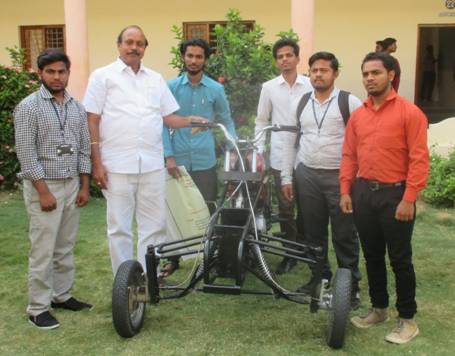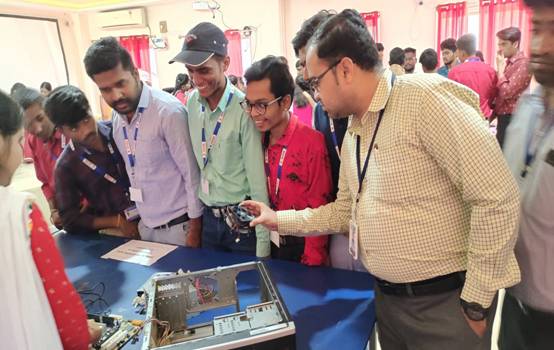

Best Practice 2
POGIL:
A POGIL activity is designed to be used with self-managed teams that employ the instructor as a facilitator of learning rather than as a source of information.
POGIL activity is designed to be used with self-managed teams that employ the instructor as a facilitator of learning rather than as a source of information. A POGIL activity guides students through an exploration to construct, deepen, refine, and/or integrate understanding of relevant disciplinary content.
Classroom implementation:
Students in a POGIL classroom may work in small groups of three or four to tackle a specifically designed activity. Each student is assigned a role, such as a task manager, recorder, spokesperson or reflector. The instructor acts as a facilitator who listens to the discussions between students, intervening at appropriate times to help facilitate student learning. Built into the experience is the support of a variety of important process skills, including communication, teamwork, and critical thinking, which translates to a more complete understanding of the entire concept, and a lasting understanding of the material.
The POGIL Project:
The POGIL Project has earned numerous grants from the National Science Foundation and other sources. The POGIL Project is based on an understanding of the important components of an effective faculty development structure.
There are two crucial aspects to the design of a POGIL activity. First, sufficient appropriate information must be provided for the initial "Exploration" so that students are able to develop the desired concepts. Second, the guiding questions must be sequenced in a carefully constructed manner so that students not only reach the appropriate conclusion, but also develop various process and learning skills. Thus, POGIL activities follow the structure of the learning cycle of exploration, concept invention, and application.
3. The Context
The study of the social context within the classroom is a complex examination of relationships that are continually changing, influencing and being influenced by such factors as behaviors, emotions, attitudes, beliefs and perceptions. The teacher provides learning experiences based on the analysis on context. It means “testing knowledge internally”. Here, concepts, relationships and generalizations are dealt with through the use of imagination and feelings.
4. The Practice:
In order to achieve our primary purpose of preparing educators who possess intellectual autonomy and professional responsibility, our work centers on three goals and their respective objectives. The main objective is to direct students mind in constructive activities with positive outcomes through the facilitation of creative and critical thinking. This would help them to develop self-confidence and self-esteem. These variables influence each other and, in turn, are influenced by this context and by forms of knowledge or discourses. These variables can create systems, but these systems are always incomplete in the sense that they have gaps, and these gaps open spaces for resistance, of many forms.
By micromanaging their students, often due to their fear of losing classroom control, teachers can burn themselves out due to the effort they have to extend in preparing detailed lessons, and the stress they put on themselves to always watch their students. If instead of micromanaging their students, teachers can learn how to empower them, teachers will make their own lives easier, avoid burnout, and help students take responsibility for guiding their own learning. They will thus benefit their students, themselves, and our society overall. It seems counter-intuitive, but by giving students power, teachers gain power and better classroom control.
5. Evidence of Success
Teachers can avoid micromanaging their students by gradually building students capabilities and giving them greater. Teachers can avoid micromanaging their students by gradually building students capabilities and giving them greater control and choice over their own learning. They can build students’ confidence by encouraging them during the process.
Early in the year, teachers can guide students through learning processes such as inquiry projects. As the year proceeds, teachers can begin to provide less detailed criteria and more choices to students. They can provide students with general directions and goals and allow the students to direct their own learning.
By allowing variety, teachers can foster students’ abilities to think outside the box and demonstrate their valuation of varied abilities, or multiple intelligences.
For those students who are not motivated teachers can consider that these students have probably been forced to conform to industrial, educational processes that are not in their style, and they have become apathetic or they have lost their confidence or interest in learning. They can build their students’ self-esteem and help to reframe positive self-identities that help students feel they can influence their environments positively. They can introduce their students to the work of inventors, such as Edison, who understood failure to be a natural and healthy part of learning. Teachers can empower their students through student-focused lessons that engage them in inquiry and reflection and that are nurtured in and through relationships.
Teachers provide a variety of learning experiences, including individual and collaborative learning, interactive and participatory approaches. Discuss how they can improve/impact the community/ environment/ health and fitness of the students and choose the focus area for the project. Brainstorm and create mind-maps on the chosen area. Identify the causes they want to support and choose one/or more ways of carrying it forward. Outline the objectives of the projects they have chosen and present plans for the implementation as well as ways of measuring the success of the project. Assign roles to each member of the class community by consensus. Ensure each and every student is included. Seek guidance from the teacher when they need it. Learn how to plan, implement, review and take responsibility for their decisions.
Trusting their students is important. Teachers can believe in the ability of students to guide their own learning and their ability to do the work that has to be done. By trusting their students, teachers create trusting environments, build capabilities, and empower students to manage themselves.
Teachers can reach these students by recognizing what factors are affecting varied students. For those who are bored, teachers can provide extension or challenge activities that link into the students’ interests. For those who are apathetic, teachers can work to design activities that tie into and then build from their interests.
For those who have lost motivation, teachers can provide positive feedback and care. For all students, teachers should work to build relationships with them in a classroom that is a community based on care and respect of individuality.
Teachers can also change how their students think about failures. They can introduce their students to the work of inventors, such as Edison, who understood failure to be a natural and healthy part of learning.
6. Problems Encountered and Resources Required:
The following are the problems we encountered throughout the Societal Empowerment:
• Identify the causes they want to support and choose one/or more ways of carrying it forward.
• Outline the objectives of the projects they have chosen and present plans for the implementation as well as ways of measuring the success of the project.
• Assign roles to each member of the class community by consensus. Ensure each and every child is included.
• Learn how to plan, implement review and take responsibility for their decisions.

Project work by the students
The Students of IV B.Tech MECH had done the project on the topic of “Car with bike engine”. It has done with less cost like a sports model car.

Project work by the students
The Students of III B.Tech MECH had done the project on the topic of “Tilting Bike”. It is mainly used in Hill Stations.

Project work by the students
The Students of IV B.Tech MECH had done the project on the topic of “Fabrication of Self Inflating Tyre system”. In this project when the tyres become inflated it can automatically refill. So that there will be no accidents.

Project work by the students
The Students of II B.Tech CSE had done the project on the topic of “Assembling the parts of computer”.